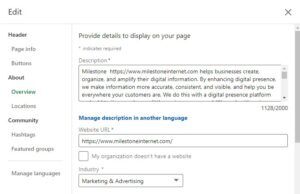
In this article we will talk about digital markets. These markets feature a range of characteristics such as network effects. They can also be flexible, scalable, scalable, and have control data. These characteristics make digital platforms crucial for identifying the right markets. This article will also include information about content marketing, native advertisements, and multi-channel advertising.
Content marketing
One of the best ways to gain more customers is through content marketing. Content marketing can help you reach large audiences at all stages in the customer lifecycle. This marketing strategy can also produce immediate results as the first impression often drives actions. It is possible to combine content marketing with digital marketing tactics in order reach more people.

Native advertising
For brands looking to reach new audiences and build leads, native advertising in digital markets can be a powerful strategy. The concept of native advertising is similar to standard marketing. The publisher wants to generate revenue through ads, while the client seeks to maximize its return on investment by increasing brand awareness. Native advertising must be relevant for the audience and address its needs in order to succeed.
Multi-channel marketing
Companies are increasingly integrating data gathered from different channels into one campaign. This will allow for more targeted marketing campaigns and improve efficiency. Your success rates will rise if your visitors have a consistent experience. One example of this type of marketing strategy is post-click landing pages. These pages allow you the flexibility to tailor the message to your visitors' needs.
Permission marketing
Your permission marketing campaign's first message should be informative. It should also promote further interaction with your target audience. These messages can take the form of a printed advertisement, a banner on a website or a social media ad. The next step after the initial message has been sent is to determine which segments of your target audience might be interested in your product. By asking a few basic questions, you can segment your lists and personalize your content for each audience segment.
Sponsored Content
Sponsored material is a great way for brands to get more attention. It can range from instructional articles to whitepapers or how-to guides. The key is to first understand your audience. It is important to understand their demographics, as well as their interests and problems. Next, you should focus on providing value.

Internet of Things
Despite all the challenges, IoT markets and digital markets offer a lot of promise. Cloud services can be used by companies to connect their devices to the cloud. This allows them monitor, control and analyze their data. These new technologies come with privacy risks. Concerns over privacy are raised by the California Consumer Privacy Act (or the General Data Protection Regulation) and how companies can protect it. This report examines the implications of these laws for investors, businesses, and suppliers.
FAQ
Why is content marketing important?
HubSpot reports that the average person spends almost two hours per day reading content, on social media and in their newsfeeds. They also watch TV, read magazines, browse websites, listen to podcasts, or look at newspapers. This is a lot of content consumption!
How long does it take to get started in content marketing?
It depends on how large your business is. Smaller companies usually don't have enough resources to invest in content marketing immediately. But it can pay big-time if your are willing to put in the time.
Why do I need to have a Content Marketing Strategy. Why not send out emails or share social media updates?
There are two main reasons that you might ignore a Content Marketing Strategy.
-
Perhaps you think email marketing and social networking posts are enough for people to talk about your brand.
-
This type of content might not be practical if you haven’t yet tried social media posting or email marketing.
Both of these assumptions are false.
Email marketing and postings on social media can be great ways of communicating with prospects and customers. However, they aren't enough by themselves.
Your goals can't be achieved by an email campaign. An email campaign alone won't help you reach your goals. It must be part of larger strategies. And social media posts alone won't help you achieve your goals either. They should be part a bigger plan.
This is where a Content Marketing Strategy can help. You can control your entire content creation process by having a clear strategy.
This will allow you to focus more on the essentials of running your business like growing your audience or increasing conversion rates.
While there are many advantages to having a Content Marketing Strategy in place, it does not make it easy.
However, a strategy is a key to success.
Should I hire a writer to write my Content Marketing?
No! No. You don't have to hire a professional writer in order to create content for your company. There are many free resources available that can help you get going.
Statistics
- According to our research, 65% of companies with very successful content marketing in 2021 ran content audits at least twice a year. (semrush.com)
- Seventy-two percent business to business (B2B) (mailchimp.com)
- Content marketing produces 3X more leads per dollar spent. Content marketing costs 62% less than traditional marketing. (criteo.com)
- Measure your goals with a progress indicator of 0-100%. Make your goals collaborative and transparent (semrush.com)
- This marketing strategy landed Ford a 15.4% conversion rate. (neilpatel.com)
- In fact, would pay more for a better customer experience, and 86% of B2B buyers would pay more. (neilpatel.com)
- Progress indicators (0–100%) allow each team member to see how attainable each goal is and understand what remains to be accomplished. (semrush.com)
- According to our research, brand awareness, attracting traffic, and generating leads remain the key content marketing goals in 2022. (semrush.com)
External Links
How To
Infographic Design Tips for Content Marketing
Infographics are one of the most effective ways to explain complex concepts simply, making information easy to understand. Infographics can be used to communicate your message.
For creating an infographic you'll need software such as Adobe Illustrator and Photoshop. These programs can be used to create different shapes and elements that represent your data. Then, you can add colors and fonts to make it look great. Once you are happy with your design, you can upload images to Unsplash and Pixabay for your design.
Looking at other infographics online can help you get ideas. If you want to show calories in certain foods, then you can take a picture or diagram of a food pyramid, and add pictures of the foods. You might also want to calculate how many calories are in soda pop. This can be done by taking a picture with a bottle of Coke.
After you have created your infographic, it can be shared through social media channels such as Facebook and Twitter. This allows people to learn more about the concept, even if they aren't familiar. Use hashtags to let others know what infographic you are sharing on social media. Hashtags enable users to follow along in conversations related to specific topics.
Make your infographics shorter than normal if you are creating them. An average blog post can range from 2000 to 5000 word, while an informationgraphic needs only 500 to 1000 words. This means you can easily convey more information with less space.
Remember that not all viewers can read small font sizes when designing an infographic. It is important to use large fonts and avoid relying too heavily on colors when designing your infographic. Make sure all text is legible.
These are just a few additional tips.
-
Choose an Infographic Template. There are many free templates available online and in printable formats. The most popular ones include Canva, Piktochart, and Google Slides.
-
Make your Infographic. Use the template below to create your infographic. You can use any media that suits your audience. For example, creating an infographic about the best places to eat in Seattle might choose photos of local restaurants.
-
Add text. Once you've created your infographic, add text using Microsoft Word, PowerPoint, or Canva.
-
Add images. Your infographic can also include images. These can be pictures, charts, graphs, or icons. Make sure the picture is relevant to your topic before you add it.
-
Make It Interactive. Interactive elements like buttons, maps and links can be added to your website. This will increase engagement with your audience.
-
Share. When you're done, share your infographic on social media sites like Facebook, Twitter, LinkedIn, Pinterest, and Instagram.
-
Measure. Your infographic's performance. Did people click through to your website? Did they sign up to your email list? Was your infographic received well by them?
-
Improve. Do you think there are ways to improve your infographics Do you think your infographic could be better?
-
Repeat. Repeat.